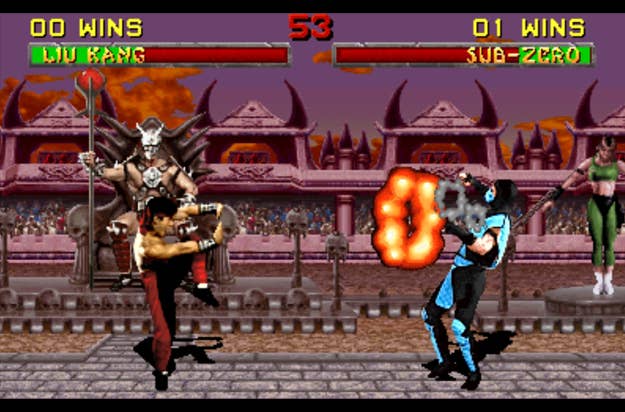Tracing the past, present, and future of game cinematics
Goodbye Kansas' Anton Söderhäll on the history of in-game cutscenes and how they have evolved
Video game graphics have come a long way from the 2D 8-bit animations we saw back in the early 1980s. The last few decades have seen major strides -- not only for video games, but also the cinematics that power these virtual worlds. Whether we're talking about in-game cutscenes or the movie quality game trailers that accompany them, there's no denying that video game cinematics have come far since their first iterations.
Yet cinematics have not only developed in terms of graphical fidelity. The evolution from pixels to photorealism has accompanied a change in the styles and formats that games are now able to explore. Cinematics have always been used to set the tone of a game, but the possibilities they provide for a game's feel are now near-endless, with further potential opening up in the future of gaming. From the 48-minute trailer for CD Projekt Red's Cyberpunk 2077 to the innovative narrative impact of Naughty Dog's The Last of Us cutscenes, cinematics both draw in an audience and keep them hooked on gameplay. But how exactly did cinematics evolve into the artistic productions we see today -- and what could the future hold for their use in gaming?

Early game graphics were rudimentary, but functional and accessible: simple pixels on a screen could bring you on a journey to shoot bullets in space, to speed down a racing track, or simply to hit a ping-pong ball back and forth. The cultural relevance of characters from early arcade or platform games -- such as Pac-Man or Super Mario -- demonstrates their continued accessibility throughout several decades of game evolution. While graphical output in these first arcade and platform games provided the 'building blocks' of their gameplay, cinematics allowed narrative and character-based elements to develop, building a player's emotional connection to the game.
In the initial years of gaming, motion capture for animation was also in its elementary stages, with rotoscoping utilised as the main form of digitally recreating a performance. This involved manually drawing frames, one by one, on top of the filmed digital material -- similar to early Disney movies such as Cinderella or Alice in Wonderland. The early Mortal Kombat games used this system to create their sprites (computer graphics that can be manipulated on-screen as a single entity), where actors undertook full wardrobe and makeup sessions before being filmed in the now-iconic poses of martial arts game characters. The footage was then transformed into 2D pixel graphics, giving players the opportunity to play across multiple distinguishable sprites in the fighting game.
We already see cutscenes that include customised character assets, but this could soon extend to trailers themselves.
In the 1980s, marketing in the gaming industry took an 'infomercial' approach: if you couldn't sell a game from its look, you'd just have to tell everyone how cool it was. A decade on, graphics had improved immensely from the previous 8-bit style, but commercials still combined real-life filming with in-game footage, often merging the two formats into stories that related to the gameplay while targeting specific audiences.
Soon there were further noticeable changes across game cinematics, provoked by the increased accessibility of home gaming after the console market was revived in the 'tech-race era' with the Nintendo Entertainment System (NES), followed by the Game Boy handheld console and the release of the PlayStation in 1994. This switch from arcades to home entertainment systems brought about exponential market growth: more buyers meant bigger budgets, and game developers could recoup more investments in a game. Additionally, with more time on players' hands -- instead of the often compressed experiences of arcade games -- developers could start telling bigger, longer stories.
Innovative styles of cinematics emerged, with games like the Diablo series pushing the boundaries of tone and structure using stylistic techniques. As a game's graphical output advanced alongside its technology, the urge to show more of the game style and feel increased, and trailers began to use graphics to demonstrate the intended atmosphere of the game. This facilitated a deeper connection between story, player, and game, and started the advance of game trailers resembling the movie-like promos we see today.
Although gameplay still took priority, the shift towards atmospheric cinematics would create an emotional impact for certain games that could then start using it as a unique selling point. Narrative richness did not only have to derive from the choices or actions made in-game, but could be drawn out through the design of its cutscenes and graphical style.

One impact of the massive online gaming surge from the 2000s onwards was how game formats began to develop, merge, and split. Multiplayer and mobile platforms offered an evolution of 'shoot 'em up' styles into the world of strategy and co-op gaming, whereas for those who enjoyed a role-playing adventure, games had space open up into narrative formats that were as visually appealing as they were emotionally compelling. In the early days of narrative-based gaming, there was unease about the financial implications. Yet we've seen these narrative games evolve to become the blockbusters we see topping sales lists today, and even transcending the gaming sphere into film and TV -- such as the upcoming HBO adaptation of Naughty Dog's The Last of Us.
Graphical advancement means overacting is no longer necessary to portray emotion to the player
Two clear strands of narrative games emerged during this time. Linear storylines set a path with cinematics placed in-between missions, so while you can't affect the story, it affords power to the game developers to direct a story in the way they want to tell it; as shown in early games of Sony's Santa Monica Studio God of War franchise. If you prefer more choice, adaptable narratives are affected by your actions and can have multiple storyline paths, such as in The Elder Scrolls. In either case, cinematics began to offer an emotional impact to the player through visual storytelling, not overshadowing, but building on top of, the atmosphere laid out by the interactive gameplay. In moving a storyline onto its next stages, cinematics allow players a breather -- such as after an ultra-focused mission -- or to open up the dramatic affectivity of the coming sequences in-game.
The harmony of high-quality visuals and complex storytelling was ideal for game cinematic trailers, allowing them to highlight the depth of the game through an innovatively condensed format -- while still maintaining the mystery of the storyline. Launch trailers are now huge features for the gaming market, with announcements appearing at fan conventions and garnering massive traction on social media.
With each evolution of gaming technology, graphical output has created more and more potential for cinematics. Instead of small teams working on developing an entire game, there will be entire teams dedicated to niche areas, with specific artist roles required for aspects such as sunlight shading or tree design. While this means individual artists have less impact on the overall look and feel of a game, it has certainly enabled studios to push graphics to a whole new level with each generation of gameplay.
One potential evolution in narrative cinematics is not only the ability to see the impact of your choices in conversation, but -- as visual fidelity improved -- starting to look for cues in the faces of those around you. Previously 'gimmicky' interactivity functions during cutscenes, such as "Press X to continue conversation", might turn into game design factors where a player can read the nuances in acting, allowing an expansion of emotional narrative elements through cinematics.

On the performance capture side of cinematics, graphical advancement has meant that overacting is no longer necessary to portray an emotion to the player. While body language used to be exaggerated -- as if in a play -- in the current cycle of game design cinematics, even in-game cutscenes are advanced enough to use 'film language' in expressing acting nuances and close-ups thanks to the capabilities of modern real-time engines. This opens up doors for games to work with actors in a much more intense way, even allowing the narrative to evolve in line with the actor. While offline-rendered cinematics will always be a higher fidelity -- giving that extra push towards an immersive gaming experience -- real time graphics are now at a high enough standard to buy into a realism that will only develop in the coming years.
The potential for cinematics in video games seems limitless. As graphics improve, so does the ability not only to customise a role-playing character but to portray it in cinematics. In long-form narrative games, we have already started seeing real-time cutscenes that include customised character assets -- such as hairstyles or items. But this could soon extend to trailers themselves. The surge in on-demand gaming services could lead to more regular instalments of games, resembling seasons of a TV show, in which case cinematics would act as an ongoing factor. This may allow for doors opening up such as seeing your personalized character within a game trailer, making such cinematics even more valuable and potent to drawing in audiences.
It's still early days for gaming in the cloud, but the possibility of having advanced tech being more readily accessible to a wider audience would mean more data power, pushing the speed of real-time graphics development. This could then mitigate a key challenge of the three to five year game development cycle, where you don't know what else might be out there at the time of release, and therefore how to stay ahead of -- or at least in line with -- the curve. Cloud computing may make this easier to predict during the development stages. However, one difficulty that could arise from this is the normalisation of top-level graphic fidelity in cutscenes, adding extra pressure on game developers to stay ahead of audience expectations in facial rigging, performance, and interactivity.
With the future of gaming technology still uncertain, there is incredible potential for cinematics to develop even further as unique artistic experiences in their own right. With even more advanced platforms and communities like the metaverse gaining traction, we can only wait to see what the next few decades in gaming cinematics will deliver.
Anton Söderhäll is an executive producer at Goodbye Kansas Studios, which creates visual effects, digital animation and motion games for video games, films and commercials








